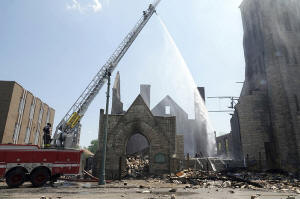Fire at historic Black church in Memphis was intentionally set,
investigators say
[May 22, 2025]
By ADRIAN SAINZ
MEMPHIS, Tenn. (AP) — A fire that severely damaged a historic Black
church that served as the headquarters for a 1968 sanitation workers’
strike, which brought the Rev. Martin Luther King Jr. to Memphis, was
intentionally set, investigators said Wednesday.
The fire at Clayborn Temple, which was undergoing a yearslong
renovation, was set in the interior of the church, the Memphis Fire
Department said in a statement. Investigators are searching for a person
suspected of being involved with the blaze.
Flames engulfed the downtown church in the early hours of April 28.
Later that day Memphis Fire Chief Gina Sweat said the inside of the
building was a total loss but there was still hope that some of the
facade could be salvaged.
The fire department said May 14 that the building had been stabilized
and investigators would use specialized equipment to study the fire’s
cause.
“Clayborn Temple is sacred ground — home to generations of struggle,
resilience and creativity,” Anasa Troutman, executive director of
Historic Clayborn Temple, said Wednesday. “This act of violence is
painful, but it will not break our spirit.”
Located just south of the iconic Beale Street, Clayborn Temple was built
in 1892 as the Second Presbyterian Church and originally served an
all-white congregation. In 1949 the building was sold to an African
Methodist Episcopal congregation and given its current name.
Before the fire it was in the midst of a $25 million restoration project
that aims to preserve the architectural and historical integrity of the
Romanesque revival church, including the revival of a 3,000-pipe grand
organ. The project also seeks to help revitalize the neighborhood with a
museum, cultural programing and community outreach.

King was drawn to Memphis in 1968 to support some 1,300 predominantly
Black sanitation workers who went on strike to protest inhumane
treatment. Two workers had been crushed in a garbage compactor in 1964,
but the faulty equipment had not been replaced.
On Feb. 1 of that year, two more men, Echol Cole, 36, and Robert Walker,
30, were crushed in a garbage truck compactor. The two were contract
workers, so they did not qualify for worker’s compensation, and had no
life insurance.
Workers then went on strike seeking to unionize and fighting for higher
pay and safer working conditions. City officials declared the stoppage
illegal and arrested scores of strikers and protesters.
[to top of second column]
|

Firefighters douse the historic Clayborn Temple, a landmark
from the civil rights movement with ties to Martin Luther King Jr.,
with water after it caught fire, April 28, 2025, in Memphis, Tenn.
(AP Photo/Karen Pulfer Focht, File)

Clayborn Temple hosted nightly meetings during the strike, and the
movement’s iconic “I AM A MAN” posters were made in its basement.
The temple was also a staging point for marches to City Hall,
including one on March 28, 1968, that was led by King and turned
violent when police and protesters clashed on Beale Street. One
person was killed.
When marchers retreated to the temple, police fired tear gas inside
and people broke some of the stained-glass windows to escape. King
promised to lead a second, peaceful march in Memphis, but he was
shot by a sniper while standing on the balcony of the Lorraine Motel
on April 4.
After King was assassinated and the strike ended with the workers
securing a pay raise, the church’s influence waned. It fell into
disrepair and was vacant for years before the renovation effort,
which took off in 2017 thanks to a $400,000 grant from the National
Park Service.
Clayborn Temple was placed on the National Register of Historic
Places in 1979. A memorial to the sanitation workers, named “I AM A
MAN Plaza,” opened on church grounds in 2018.
About $8 million had been spent on the renovations before the fire,
and the exterior had been fully restored, Troutman said.
She said in a recent interview that two chimneys had to be
demolished before investigators from the Bureau of Alcohol, Tobacco,
Firearms and Explosives could safely work on the property, but the
church organ had been removed before the fire.
As the fire was burning, she said, people went to the “I AM A MAN”
memorial and stood at a wall where the names of the striking
sanitation workers are listed.
“I watched that wall turn into the Wailing Wall, because people were
literally getting out of their cars, walking up to that wall and
wailing, staring at the building on fire,” she said.
All contents © copyright 2025 Associated Press. All rights reserved |